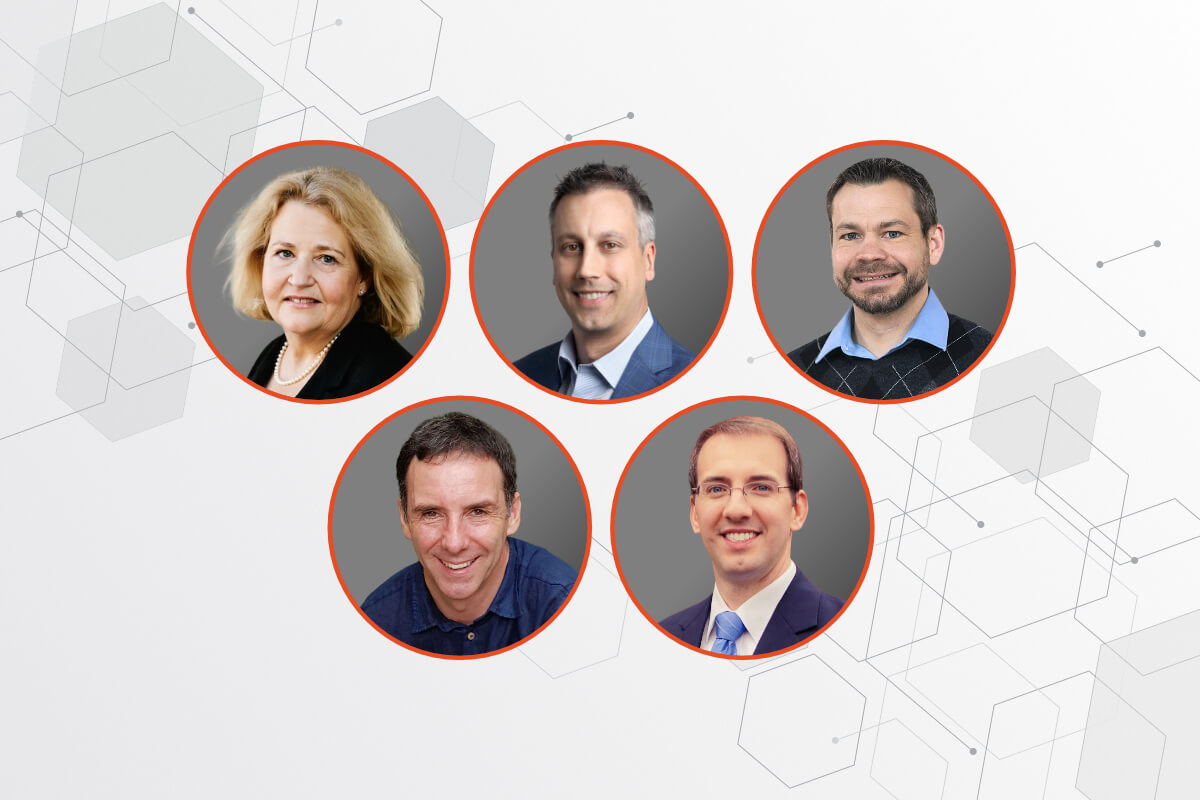IIoT World’s Board of Advisors Envisioning 2024’s Industrial Transformation
In an exclusive insight into the future of industries, we sat down with our esteemed Board of Advisors to delve deep into the technology landscape of 2024. Our advisors, Marcia Gadbois, President of Adisra; Jeff Winter, Sr. Director of Industry Strategy, Manufacturing; Michael Lake, President & CEO of Leading Cities; Kevin O’Donovan, Technology Evangelist, and Ira Sharp, Co-founder, Industry 4.0 Club, shared their visions on the evolving influence of the Industrial Internet of Things (IIoT) and Artificial Intelligence (AI). Here is a compilation of their foresight, providing a comprehensive overview of the transformative changes and opportunities on the horizon for various industries.
MANUFACTURING INDUSTRY
IIoT World: How do you envision the evolving landscape of our industry in the next year, considering the current trends and technological advancements in IIoT and AI?
Marcia Gadbois: Rapid transformation in industrial automation will continue in 2024, sparked by the growing accessibility of budget-friendly sensors and devices, edge analytics, cybersecurity measures, advances in artificial intelligence, and concerns related to energy and our environment.
According to MarketData Forecast, the global Internet of Things (IoT) market size was at USD 330.6 billion in 2022 and is expected to grow at a CAGR of 26.9% to an estimated USD 1380 billion by 2028. The rising interconnection of machines, sensors, and devices contributes to the proliferation of data, fostering advancements in data analysis, predictive maintenance, and enhanced operational efficiencies through actionable data-driven decisions. Companies can gain a competitive edge by utilizing advanced analytics on the varied datasets produced by IIoT devices. This approach makes achievable goals such as predictive maintenance, real-time monitoring, and resource optimization, contributing to a smarter and more interconnected future.
The surge in connectivity brings about a corresponding rise in ransomware attacks. The determination of organizational risk and the implementation of cybersecurity measures are reliant on the collaborative efforts of IT, OT, and security personnel. This collaboration aims to safeguard data and ensure the safety of employees, whether they are working in-office or remotely, and enhance organizational resilience.
AI will contribute to advancements in both deepfake and advanced phishing techniques while concurrently playing a significant role in the development of AI-based detection applications.
In 2024, prioritizing sustainability and reusability must be a focal point for businesses. Automation solutions designed with environmental considerations will continue to be a focus for green automation practices in the new year.
Jeff Winter: In 2024, we’ll see a surge in AI and machine learning being applied to the vast data generated by IoT devices, leading to smarter, more autonomous industrial systems. This includes the adoption of edge computing, which allows for real-time data processing and decision-making directly at the data source, significantly enhancing operational efficiency.
Another critical focus will be on cybersecurity, as the interconnected nature of these systems presents new vulnerabilities; hence, robust cybersecurity measures, including advanced encryption and AI-powered threat detection, will become indispensable.
Additionally, the regulatory landscape around AI and IoT will evolve, with a greater emphasis on governance, ethical AI usage, and management of AI systems, especially those capable of making decisions that could be biased or ethically sensitive.
These changes signify a move towards a more integrated, intelligent, and secure industrial environment, with AI taking on a pivotal role in shaping its future.
Ira Sharp: 2024 will be the year of application, particularly for AI. AI was a major buzz topic in 2023, trending up to a point where I believe it has hit the Peak of Inflated Expectations (using the Reference of the Gartner Hype Cycle). So, in 2024, we will be getting past some of the ideas that may be a bit too far out there for the near term, and we will see real particle applications of AI.
When it comes to IIoT, I am hopeful that more companies will realize that Data is the commodity of tomorrow and a crucial part of what companies need to focus on. By leveraging data, organizations can gain insights into their environmental impact and identify opportunities to reduce waste, increase efficiency, and optimize operations, enhancing sustainability. I call this Data-Driven Sustainability
IIoT World: In light of the rapid development of IIoT and AI technologies, what potential disruptions or transformative changes do you anticipate for our sector, and how can end users strategically leverage these changes?
Marcia Gadbois: The abundance of data generated by IIoT devices can disrupt traditional decision-making processes and spur manufacturers to use artificial intelligence (AI) and machine learning to extract actionable insights from vast amounts of data. This enables data-driven decision-making, leading to optimized operations and improved efficiency.
In 2024, manufacturers are anticipated to continue investments in connectivity solutions and data integration platforms. These investments aim to enable data collection, real-time analysis, and visualization utilizing IIoT software platforms encompassing comprehensive device connectivity. These platforms ensure inclusive access to data and facilitate bi-directional communications across cells, stations, plants, business systems, and the entire value stream.
AI and IIoT facilitate predictive maintenance, serving as a disruptor by analyzing equipment data to forecast potential failures before they manifest. Manufacturers are poised to embrace predictive maintenance strategies to mitigate downtime, lower maintenance expenses, and prolong the lifespan of equipment.
Edge analytics is poised to disrupt and mold the future of IIoT. This approach entails processing data at the network’s edge, near the data source, thereby diminishing latency and conserving bandwidth. This proves especially vital for IIoT applications demanding real-time data processing and decision-making. Progress in edge computing technologies is projected to fuel the widespread adoption of IIoT devices and analytic applications.
Ira Sharp: IIoT will promote the ability to collect more data. AI and Digital Transformation will enable the use of that data to make meaningful changes in operations. If applied correctly, this should become the ethos of a company driving the organization to the next level. But, to make this happen the changes and reason for the move must be understood throughout and embraced. Or, the efforts could be doomed to fail or get off the ground.
Using AI I believe there is a massive opportunity to capture knowledge from retiring manufacturing workers to help bridge the gap for the next generation. Combining operation, maintenance, and serviceability can help systems learn what is being done today to help systems and lines stay in operation. In the first step, the AI could help outline those same changes for other works, and in the second step, the machine could offer alternatives to help perform better over time. This is one of the places I believe Generative AI can come into play vs Machine Learning.
IIoT World: What opportunities do you see for small organizations to harness IIoT and AI to optimize operational efficiency, enhance decision-making processes, and stay competitive in the following years?
Marcia Gadbois: As per the National Association of Manufacturers (NAM), most manufacturing firms in the United States are small, employing less than 100 individuals. Despite their size, these entities share similar needs with larger manufacturers in the market to be competitive.
Small manufacturers will leverage sensors and cloud technology to fulfill their shared needs for collecting, analyzing, and comprehending data. This utilization aims to enable advanced analytics and predictive maintenance in their operations.
In the current economic landscape, small manufacturers can gain a competitive edge and thrive by harnessing edge analytics and cloud computing capabilities. Cloud computing provides them with essential infrastructure, robust data security, and remote access and requires minimal maintenance, offering a significant advantage.
Jeff Winter: “Even the smallest cog in a machine has its role to play” – this saying resonates deeply with small organizations venturing into IIoT and AI. Thanks to their size, these businesses have a distinct advantage in agility and flexibility, enabling them to adopt and adapt to new technologies swiftly. This agility translates into easier overall operational visibility and true end-to-end integration, tasks that can be daunting for larger companies due to their complex structures. For small organizations, a strategic focus should be on the wealth of data already produced by their equipment and manual processes. The declining costs of connecting, collecting, storing, and analyzing data mean that small businesses can gain valuable insights even without extensive investments. By tapping into this underutilized data, they can uncover operational efficiencies and opportunities that were previously hidden. In this way, small organizations can turn their size into an asset, piloting IIoT and AI solutions effectively to carve out a competitive edge in their respective industries.
Ira Sharp: With the data boom, there is a gap in making the data usable information. I believe there is an opportunity for OEMs to provide more relevant information to end users of their machines while being able to collect data to help improve their systems for the future. With this there are concerns around system accessibility and intellectual property but, I truly think these are topics that can be overcome, resulting in a much stronger future for manufacturing
Additionally, there is a rise of a new class/ type of system integrator. An integrator that does not specialize in PLC programming, motion, robotics, or process optimization but on Data. How to collect data, move data, store, use, ect. This solutions architect for the data system will become paramount in the future and is a huge opportunity for smaller companies to define a clear position in this area. Or another option is to use more purpose-built systems, which lessen the need for custom integration for data. However, that comes at a cost of flexibility.
IIoT World: From your perspective, what emerging IIoT and AI applications or use cases do you believe will significantly impact your industry?
Marcia Gadbois: With the rise of IIoT and AI, the industry will deploy more analytics on the edge. Analytics on the edge expedites the data journey from a device to a secure edge, simplifying its management. Furthermore, it delivers precise data and valuable insights, facilitating informed decision-making, cost reduction, and real-time seamless operations.
IIoT and AI will also facilitate predictive maintenance at the machine and process levels. The transformative approach enhances reliability, cuts costs, and boosts productivity. The adoption of predictive maintenance not only gives businesses a competitive edge but also ensures a streamlined and efficient operation.
Jeff Winter:
When considering the impact of emerging IIoT and AI applications in our industry, the question can be approached from two angles: internal operations and external customer value.
IoT and AI are set to revolutionize productivity, reduce costs, and enhance the quality of internal operations. Top applications like predictive maintenance will significantly reduce downtime by preemptively addressing equipment issues. AI-enabled inventory management, anomaly detection, and demand forecasting will streamline operations, making them more efficient and responsive to market needs.
Externally, these technologies will be integrated into smart products, offering more personalized and unique customer experiences. Generative AI will transform customer engagement, creating more interactive and tailored interactions. The deployment of advanced chatbots, powered by custom-built GPT AI models and Natural Language Processing (NLP), will revolutionize customer service. These AI-driven interactions could become so refined and efficient that customers might prefer interacting with a company’s chatbot rather than a human representative. This dual approach, enhancing internal efficiency and external customer experience, positions IIoT and AI as key drivers of transformation in our industry.
Ira Sharp: I think Data will have a major impact throughout manufacturing. Improving operations, measuring and reporting on sustainability efforts, providing more meaningful work for manufacturing workers, improving HR systems, and providing more directed support for machine systems and processes. While the Fieldbus may have extended the usefulness of a PLC in manufacturing collecting and data will prove to be the next big leap
ENERGY INDUSTRY
IIoT World: How do you envision the evolving landscape of our industry in the next year, considering the current trends and technological advancements in IIoT and AI?
Kevin O’Donovan: We are in for a wild ride in 2024, even more so than in 2023. It’s clear that the pace of technological evolution is not slowing down anytime soon, and sadly, world events are not getting any ‘calmer.’ Business opportunity and uncertainty will go hand in hand in 2024. With advancements in generative AI, copilots, prompt engineering, etc., the landscape is set to transform faster than we can say, “We need to change.” So, time to buckle up.
IIoT World: In light of the rapid development of IIoT and AI technologies, what potential disruptions or transformative changes do you anticipate for our sector, and how can end users strategically leverage these changes?
Kevin O’Donovan: Generative AI can have the most significant potential disruption across everything we do, be it designing things, operating things, planning things, or whatever. And those who figure out how GenAI tools can complement our daily work will have an advantage over those who do not. Now, with all that said, many people need to understand better the quality of the data they’re using for these Generative AI tools. A potential secondary disruption may be that many people will start to figure out just how good (or not) their data is in 2024.
IIoT World: What opportunities do you see for small organizations to harness IIoT and AI to optimize operational efficiency, enhance decision-making processes, and stay competitive in the following years?
Kevin O’Donovan: In my opinion, The barrier to entry for small organizations is lowering by the minute, thanks to the accessibility of SaaS-based cloud models. This means that even the little folks can now tap into the power of AI and any other type pf cutting-edge software, turning their coolest ideas into reality. Before this, enabling technology was only something the big boys and girls could get access to. So, this continued democratization can be a bit of a game-changer for small businesses and startups, opening up all sorts of opportunities.
IIoT World: From your perspective, what emerging IIoT and AI applications or use cases do you believe will significantly impact your industry?
Kevin O’Donovan: While I’d see GenAI as the vital disruptor in 2024, keep your eyes on the emergence of more immersive collaboration technologies. I know VR, AR, and XR have been teasing us for years, yet the upcoming release of Apple’s Vision Pro could be interesting. It could get exciting if this device has an iPhone and/or iPad moment in the Enterprise/Industry. Apple is not the only game in town, but it could drive a new wave of immersive collaboration and spatial computing use cases.
SMART CITIES
IIoT World: How do you envision the evolving landscape of our industry in the next year, considering the current trends and technological advancements in IIoT and AI?
Michael Lake: In the smart cities space, AI has the potential to open government up more than at any other point in history; it can improve service delivery for residents, visitors, and workers in our cities. However, it will take time for most cities to fully understand and apply AI in ways that meet its full potential. We are already seeing some cities leading efforts to develop policies dealing with AI technologies. Major city network organizations worldwide are creating support systems for local governments to leverage AI more efficiently and effectively while mitigating risks.
IIoT World: In light of the rapid development of IIoT and AI technologies, what potential disruptions or transformative changes do you anticipate for our sector, and how can end users strategically leverage these changes?
Michael Lake: Governments worldwide are huge data repositories—this data has untapped value in improving lives, supporting communities, and providing better services. Perhaps among the most basic but most outward-facing applications of AI in cities would be the use of AI to provide constituents with access to programs, services, or other government offerings that they qualify for but are currently unaware of. The disruptive nature of such an application is not in the direct impact itself. However, recognizing that before a city government is likely to release an AI-based solution that is so outwardly facing, it will have had to build a deep trust for the solution and its accuracy. When such trust is achieved, the flood gates of change and the realization of AI’s impact on local governments will truly begin.
IIoT World: What opportunities do you see for small organizations to harness IIoT and AI to optimize operational efficiency, enhance decision-making processes, and stay competitive in the following years?
Michael Lake: The power of AI can support smaller organizations by significantly improving their current outputs. This is not to say that AI will replace team members or prevent new positions from being added, but it does mean that the quantity and, perhaps, the quality of team member outputs will increase dramatically in time. The shift will most certainly be seen in the amount of information that is conveyed to the public, and that will require a more thoughtful screening by team members to be more selective of the content they are producing rather than communicating all content that can be created. It becomes a curation role rather than a content development role—this requires higher levels of strategic thinking to leverage AI’s possibilities for the organization entirely.
IIoT World: From your perspective, what emerging IIoT and AI applications or use cases do you believe will significantly impact your industry?
Michael Lake: There are so many—many already being used, but even more not yet created. But as it relates to local governments, I believe that the ability for a person to share sensitive personal information without divulging it to another person will encourage more people to reach out to governments, understand how their local government can support them, and pursue those opportunities with a clear understanding of the process, while maintaining your privacy. As I said earlier, because of the sensitive nature of such information, when the government has enough trust in AI to leverage it, I believe the impact will begin to take shape. AI will become as ubiquitous as paying taxes.
Download the brochure



